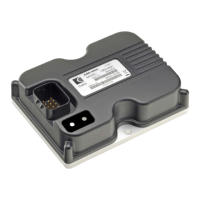35
Curtis 1352 eXm Manual, R ev. D
The Curtis 1352 includes bypass capacitors on the printed circuit board’s
sensitive input signals to reduce the impact of this RF energy on the internal
circuitry. In some applications, additional filtering in the form of ferrite beads
may also be required on various wires to achieve desired performance levels. A
full metal enclosure can also improve immunity by shielding the 1352 from
outside RF energy.
ELECTROSTATIC DISCHARGE (ESD)
Curtis products, like most modern electronic devices, contain ESD-sensitive
components, and it is therefore necessary to protect them from ESD (electrostatic
discharge) damage. Most of the product’s signal connections have protection
for moderate ESD events, but must be protected from damage if higher levels
exist in a particular application.
ESD immunity is achieved either by providing sufficient distance be-
tween conductors and the ESD source so that a discharge will not occur, or by
providing an intentional path for the discharge current such that the circuit
is isolated from the electric and magnetic fields produced by the discharge. In
general the guidelines presented above for increasing radiated immunity will
also provide increased ESD immunity.
It is usually easier to prevent the discharge from occurring than to divert
the current path. A fundamental technique for ESD prevention is to provide
adequately thick insulation between all metal conductors and the outside envi-
ronment so that the voltage gradient does not exceed the threshold required for
a discharge to occur. If the current diversion approach is used, all exposed metal
components must be grounded. The shielded enclosure, if properly grounded,
can be used to divert the discharge current; it should be noted that the location
of holes and seams can have a significant impact on ESD suppression. If the
enclosure is not grounded, the path of the discharge current becomes more
complex and less predictable, especially if holes and seams are involved. Some
experimentation may be required to optimize the selection and placement of
holes, wires, and grounding paths. Careful attention must be paid to the control
panel design so that it can tolerate a static discharge. MOV, transorbs, or other
devices can be placed between B¬and offending wires, plates, and touch points
if ESD shock cannot be otherwise avoided.
APPENDIX A: EMC & ESD DESIGN CONSIDERATIONS

